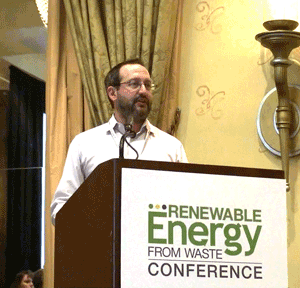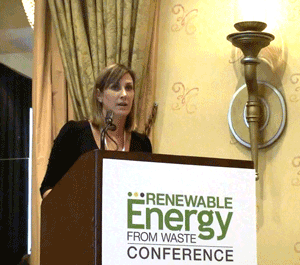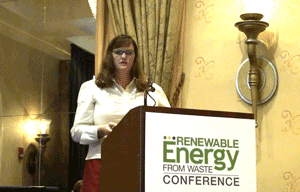Kroger, Shaw and Cemex all use discarded materials to create energy for various business uses.
 |
| John Winkels |
During the Renewable Energy from Waste Conference held in mid-November 2013, John Winkels of the Kroger Co. Inc., told attendees that starting an anaerobic digestion system at the company’s Ralphs/Food 4 Less distribution center in Compton, Calif., was a positive return on investment for the grocery store chain. California’s ban on commercial food waste, in addition to the company’s “zero-waste” goal prompted Kroger to look at alternatives to food waste disposal. The project offsets about 80 percent of the natural gas used at the distribution facility. Anaerobic digestion also has saved the company the expense of trucking waste to a composting facility two hours away.
“The renewable energy benefit isn’t the majority of the benefit,” Winkels explained to conference attendees. “The majority of the benefit is the trucking offset.”
Winkels said the project saves Kroger 500,000 miles per year in trucking costs. Sorting material for use in the digester also was simpler than prepping it for composting. Any waste containing organic material can be used in the system according to Winkels.
Another secondary benefit Kroger has experienced is the customer and associate engagement, he said. “This is something that customers and our associates get excited about,” said Winkels.
“It hasn’t been without growing pains, but it has been operating for over a year now and we are pleased with the results,” Winkels concluded.
 |
| Ashley White |
Ashley White, manager of logistics sustainability at Kroger told attendees that producing fuel from AD actually has a negative carbon dioxide output where it actually offsets more than is produced. “This is a really unique opportunity that moves these sort of projects along,” she said.
White talked about where Kroger was headed in the future with AD. While the company is already producing electricity and natural gas, she said the company is considering using renewable natural gas (RNG) in its fleet. She noted that the cost of using the digester biogas to make RNG for trucks is a more expensive use.
 |
| Jay Henry |
Following the presentation from Kroger, Jay Henry, director of operations support for Shaw Industries Group Inc., Dalton, Ga., posed the question, “What if carpet never had to go to a landfill?”
The world’s largest carpet manufacturer’s first major investment in renewable energy was in a waste-to-energy gasification plant back in 2005. It uses carpet trimmings and flooring dust from the production process to create steam. Because the company uses steam to dye its carpet, he said, opportunities to use this type of technology.
Henry acknowledge that post-consumer carpet is where the real issues with disposal exist. He noted that 3.5 million pounds of carpet ends up in landfills per year. “That’s just unacceptable,” he told attendees. Henry said that while it is the consumers who are disposing of Shaw’s product, the company “We want to do things that are going to help take responsibility for that product.”
We are the leader in our industry for recycling. Also the largest carpet recycler in the world. Carpet can go three different ways. Nylon 6 carpet can be made into new carpet; nylon 6,6 and polypropylene can be made into new plastic parts. The other type of carpet, polyester or PET carpet, that is not the case. “It cannot be recycled feasibly,” he said. “There are not a lot of opportunity uses there so we use that for carpet energy.”
He talked about the company’s Re2E plant which was featured on the cover of Renewable Energy from Waste in Fall 2012. It is the first energy plant that is fully fueled by carpet. A mixture of 60 percent post consumer and 40 percent post industrial.
“We built it because it is an enabler,” explained Henry. Being able to take in all types of postconsumer carpet keeps costs down. “When we can take that PET carpet and use it here as a fuel it enables the recycling of other carpets to take place,” he said.
The carpet arrives baled and is source separated. The carpet then goes through the following steps to become energy and steam.
- Carpet bales are coarsely shredded;
- Carpet is conveyed into two-stage metal separation system;
- Carpet enters a second stage shredder;
- Dirt, calcium carbonate removed;
- Remaining material is conveyed to fuel silo then
- Material is conveyed from the silo to a hybrid (fire-tube/water-tube) biomass boiler
- Steam is superheated and sent to the turbine; and
- Low-pressure steam goes to two carpet plants.
“It was a two-year struggle to get it where it needs to be,” said Henry. The plant produces steam for two carpet plants and produces electricity to power itself. It is designed to process 84 million pounds of carpet, although Henry noted the plant is “not quite there yet.”
 |
| Monica sowders |
Monica Sowders, alternate fuels manager for Cemex, the largest cement manufacturer in the United States, discussed the company’s use of alternative fuel sources other than coal to heat its kilns and make its product. She said Cemex’ European plans operate on 90 percent or more alternative fuels. In the U.S. the company has a goal of 50 percent coal substitution with alternative fuels noting the difference being that in the U.S. there are “no incentives and the market is very difficult.”
As a company, Sowders said, “We are looking to become flexible, creative and sustainable.”
The company operates 13 plants in the U.S. “Making cement is very energy intensive,” she pointed out. She added that the Cement making process produces no residuals so it is important to closely monitor that is being used as a fuel so because it affects the chemistry of the cement.
She said there are a lot of differences from state to state on what materials are acceptable as fuel and how they are viewed. “That can be a barrier,” she said adding, “There are huge benefits of alternative fuel.”
“We see a significant provable demonstrateable decrease in carbon dioxide emissions,” she said.
In 2012, the company used the following alternative fuels in its kilns:
tires
|
109,875 tons |
wood
|
96,856 tons |
RDF
|
5,371 tons |
biosolids
|
11,904 tons |
agricultural residues
|
43,454 tons |
ashes
|
548,502 tons |
alternative solids
|
57,056 tons |
| alternative liquids |
636,929 gallons |
The benefits of alternative fuel are not only environmental, but also economic. She said many manufacturers are working toward zero waste alternatives and have a lot of material that can’t simply be put into a bin and recycled. If there is a cement plant nearby that can serve as an outlet for the materials, then it can be in incentive for a manufacturer to locate or stay in that location.
Sowders said that people have become accustomed to coal saying it is “what our regulations have come to accept, so when they hear refuse derived fuel or engineered fuel even though the emissions are better, it is still an education process to get to the point of understanding.”
The Renewable Energy from Waste Conference was Nov. 18-20, 2013 at the Marriott West Palm Beach, in West Palm Beach, Fla.
